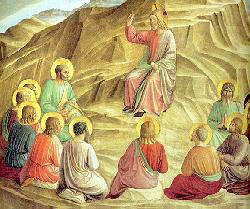Jesus as Wisdom Teacher
The eye is the lamp of the body... Jesus uses wisdom teaching to invite his hearers to see differently.
~ Marcus Borg
Jesus invites his hearers to leave conventional wisdom behind in order to live by an alternative wisdom.
Jesus as alternative wisdom teacher

Jesus’ wisdom teaching takes two forms.
Aphorisms:
- Great one-liners
- Short, pithy, memorable sayings
- Crystallizations of insight that provoke and invite further insight
- Examples:
- “If a blind person leads another blind person, they will both fall into a ditch.”
- “Leave the dead to bury the dead.”
Parables:
- Short stories
- Invite the hearer to enter the world of the story and to see differently in light of the story
- Example: story of the Good Samaritan (Luke 10:25-37)
Both aphorisms and parables are evocative and provocative forms of speech.
Most importantly they are invitational forms of speech
- Invitations to see something you might not have otherwise seen
- Invitations to see differently
 Jesus
spoke his aphorisms and told his parables many, many times.
Jesus
spoke his aphorisms and told his parables many, many times.
No great speaker of one-liners tells a great one-liner only once, no great teller of great stories tells a great story only once.
The gospels are plot summaries.
Jesus’ invitation to see differently
Seeing is central to the wisdom teaching of Jesus. There are many sayings and healing stories about seeing. How you see makes all the difference.
- What does Jesus invite people to see?
- What is this new or different way of seeing like?
- What is the different vision of life to which Jesus points and to which he invites his hearers?
 Jesus’ alternative
wisdom teaching undermines and subverts
the social boundaries generated by the
conventional wisdom of his day and ours.
Jesus’ alternative
wisdom teaching undermines and subverts
the social boundaries generated by the
conventional wisdom of his day and ours.
Jesus’ wisdom teaching points to the world of conventional wisdom as a world of blindness. His aphorisms and parables invite us to see differently.
Conventional wisdom |
Jesus’ alternative wisdom |
|---|---|
God is punitive lawgiver and judge |
God is gracious |
A person’s worth is determined by measuring up to social standards |
All persons have infinite worth as a children of God |
Sinners and outcasts are to be avoided and rejected |
Everyone is welcome around the table and in the kingdom of God |
Identity comes from social tradition |
Identity comes from centering in the sacred, from relationship with God |
Strive to be first |
The first shall be last...; those who exalt themselves will be emptied... |
Preserve one’s own life above all |
The path of dying to self and being reborn leads to life abundant |
Fruit of striving is reward |
Fruit of centering in God is compassion |
Source of Jesus’ alternative wisdom
- Where did this alternative wisdom of Jesus come from?
- Why does he see the way he sees?
- Why does he speak of conventional wisdom as way of blindness?
- How does he know of alternative wisdom?
 Jesus
himself must have had an enlightenment experience. The
reason Jesus sees differently is because he knows differently.
Jesus
himself must have had an enlightenment experience. The
reason Jesus sees differently is because he knows differently.
The radical change in perspective which characterizes the wisdom teaching of Jesus comes from a radically different experience of reality, the experience of the spirit of God.
The path Jesus travels, and invites his hearers to travel, is a way radically centered in God and not in culture.
Questions to ponder...
How do you apply Jesus’ alternative wisdom?
Think of an issue in your life or in the world today.
- What does conventional wisdom say about it?
- How does Jesus’ invitation to see differently affect your perspective and response to the issue?
What would it mean to radically center your life in God instead of culture?
The historical/cultural/social context of first century Palestine must be understood to understand Jesus’ words and deeds.
